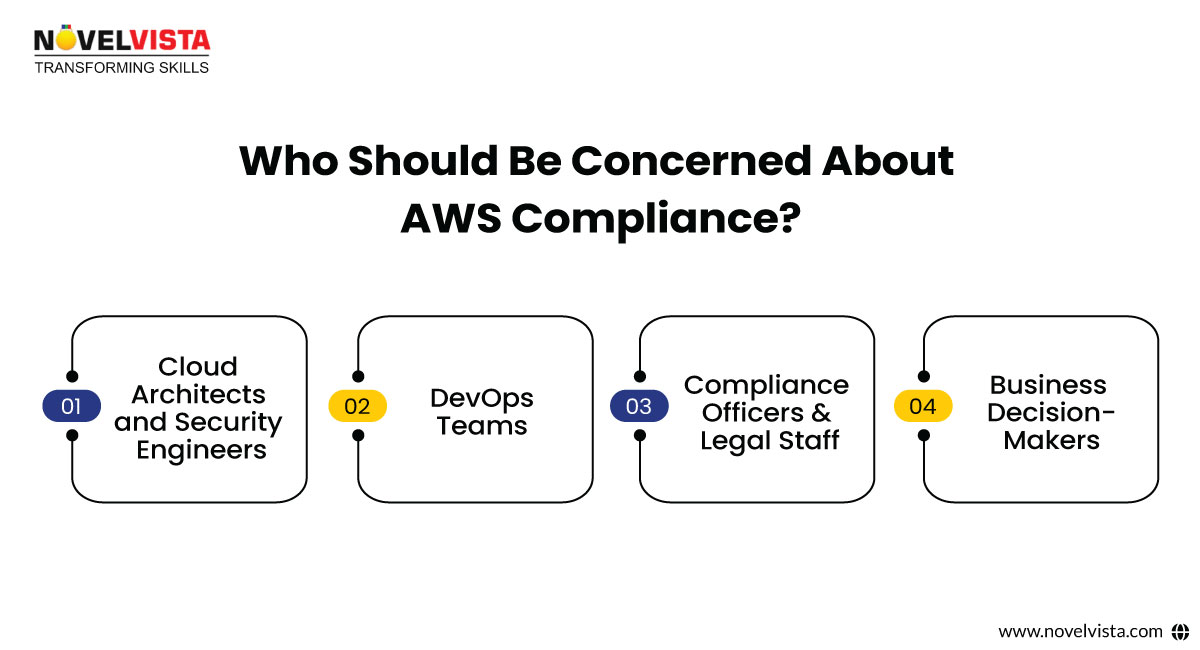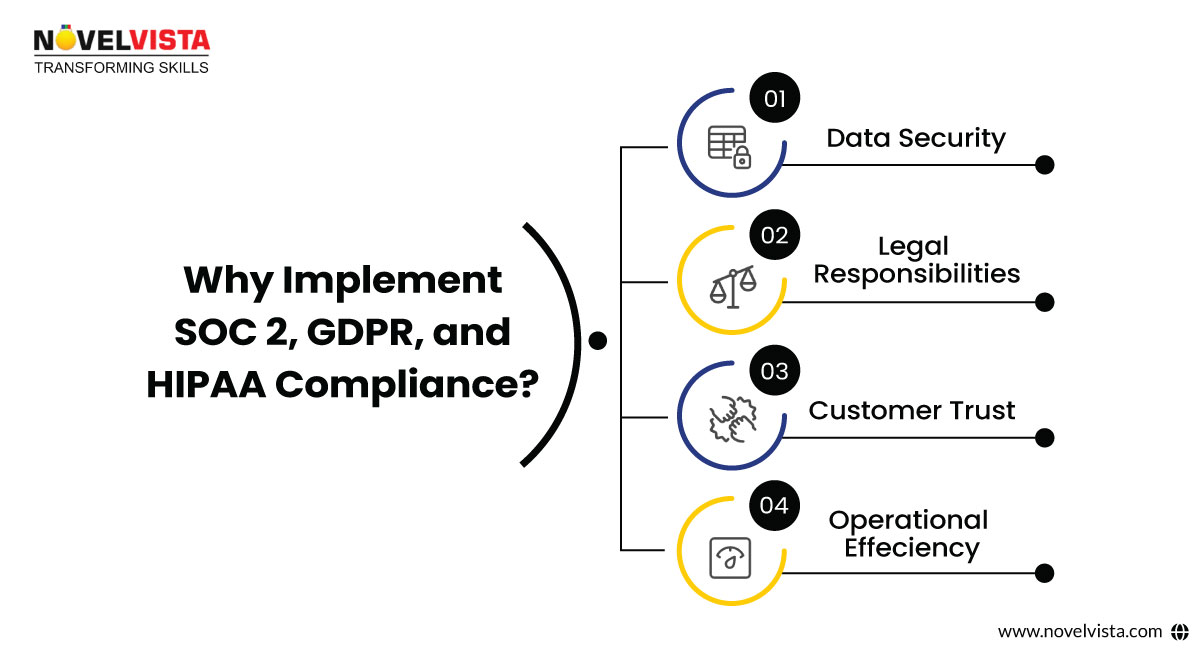With cloud adoption increasing at a rapid pace, organizations need to make sure they meet regulatory requirements to safeguard sensitive information, provide privacy, and retain customer confidence. For organizations operating on Amazon Web Services (AWS), compliance with regulations like SOC 2, GDPR, and HIPAA is essential to deal with risk and secure data.
Each of these standards has its requirements, but all of them are concerned with data security, privacy, and governance. AWS, being a prominent cloud platform, provides different services, tools, and configurations to assist organizations in achieving the requirements of these regulatory standards. This guide gives you a complete overview of SOC 2, GDPR, and HIPAA compliance on AWS, making it easier for you to deal with the intricacies of cloud security and compliance.

Companies dealing with sensitive customer information, particularly in compliance-sensitive industries, need to take compliance seriously. The most important stakeholders for compliance
work are:
Example:
A healthcare organization hosting patient data on AWS must also be HIPAA-compliant, such that all such stored and processed data is safeguarded as per the data security and privacy standards of HIPAA.
SOC 2 (System and Organization Controls 2) Compliance
SOC 2 is an audit framework that evaluates how businesses secure customer information. It's most applicable to SaaS and tech businesses, and is concerned with five main Trust Service Criteria (TSC): security, availability, processing integrity, confidentiality, and privacy.
Key Features:
Security: Guarantees the system is secure from unauthorized access.
Availability: Guarantees the system is accessible for use according to SLA.
Processing Integrity: Guarantees data processing is complete and accurate.
Confidentiality: Guarantees confidential data is secure.
Privacy: Guarantees personal data is gathered, used, stored, and shared according to privacy policies.
Example:
A fintech company needs to perform SOC 2 audits to prove to clients and stakeholders that their systems are up to the required security, privacy, and availability standards.
GDPR (General Data Protection Regulation)
GDPR is a European Union law that requires organizations to safeguard the privacy and personal data of EU citizens. It is enforced against any organization, wherever it might be, which processes the personal data of EU residents.
Key Features:
Data Protection by Design and by Default: Data protection properties have to be built into services and operations.
Data Subject Rights: Covers the right of access, right of erasure, and right of objection to data processing.
Data Breach Notification: Orders notification of leaks to regulators within 72 hours.
Data Encryption: Personal data must be encrypted both in transit and at rest by organizations.
Example:
An online store that processes EU customer personal data needs to implement GDPR compliance practices, maintaining data privacy and obtaining customer consent for data processing.
HIPAA (Health Insurance Portability and Accountability Act)
HIPAA is a federal U.S. laws that protects and maintains the privacy of sensitive patient health information. It governs healthcare providers, health insurance plans, and other organizations dealing with Protected Health Information (PHI).
Major Characteristics:
Privacy Rule: Confirms the privacy of patient information.
Security Rule: Sets security standards for the protection of PHI.
Breach Notification Rule: Mandates covered entities to inform affected individuals in the event of a data breach.
Access Control: Restricts access to PHI to only authorized individuals.
Example:
A healthcare organization that stores and processes patient health information on AWS must guarantee that all data processing and storage is HIPAA privacy and security rule compliant.
Compliance initiatives should be initiated during:
Example:
A law firm growing its cloud infrastructure needs to keep its AWS environment compliant with SOC 2, especially since it's holding more sensitive legal information.
SOC 2, GDPR, and HIPAA compliance measures should be applied across different layers of your AWS system:
Example:
An internet-based healthcare provider stores medical records in Amazon S3, with encryption by AWS KMS. They utilize AWS CloudTrail to track access and keep audit logs in place for HIPAA compliance

Implementing compliance is important for different reasons:
Example:
A SaaS provider globally adheres to GDPR and SOC 2 in order to be trusted by customers from
various regions, keeping personal information secure and minimizing the chance of expensive breaches.
To implement these compliance frameworks on AWS, it is necessary to use the correct services, configurations, and practices:
1. Implement Identity and Access Controls
IAM Policies: Create IAM roles and permissions to govern access and have only authorized personnel gain access to sensitive information.
Multi-Factor Authentication (MFA): Set MFA on for privileged users and administrative accounts to add a level of security.
AWS Organizations: Utilize AWS Organizations to organize multiple accounts under the central management and security control.
2. Data Encryption
At Rest: Employ AWS KMS or AWS CloudHSM to secure encryption keys and have your data encrypted at rest.
In Transit: Deliver TLS/SSL to protect data in transit across all applications.
Database Protection: Apply database protection feature within Amazon RDS and Amazon Aurora to safeguard PHI for HIPAA compliance.
3. Observing and Logging
CloudTrail: Allow AWS CloudTrail to keep track of all API calls and activity performed within your AWS habitat for audit purposes.
CloudWatch: Set up Amazon CloudWatch to observe system performance, log important security incidents, and trigger alerts on suspicious activity.
4. Data Storage and Retention
S3 Bucket Policies: Use S3 bucket policies to manage data access, including compliance with data privacy laws.
Data Retention Policies: Automate policies to collect or remove data depending on retention needs for GDPR and HIPAA.
5. Regular Audits and Assessments
AWS Artifact: Retrieve compliance reports and certifications through AWS Artifact to prove compliance during audits.
Third-Party Assessments: Perform periodic security audits using AWS's third-party audit reports, including SOC 2 and ISO 27001.
Example:
A worldwide e-commerce site uses Amazon RDS for customer data storage, with encryption at rest enabled through AWS KMS and monitoring through CloudWatch. They implement MFA with IAM for GDPR and SOC 2 compliance.
Use Case 1: HIPAA Compliance for a Healthcare Provider
Problem: A healthcare provider would like to move its clinical and patient data into AWS but requires HIPAA compliance on patient health records.
Solution: The provider uses Amazon RDS with encryption at rest, implements IAM roles to provide access in a controlled fashion, and uses CloudTrail for audit logging. They require that all data transferred be encrypted with TLS.
Outcome: The provider effectively implements HIPAA compliance with lower infrastructure expenses and increased scalability using AWS services.
Use Case 2: GDPR Compliance for a European SaaS Company
Problem: A European SaaS firm must ensure GDPR compliance with its customers' personal information while moving workloads to AWS.
Solution: The business utilizes AWS CloudHSM for encryption key management, enforces data retention policies for data subject rights, and implements data processing agreements with AWS. They further utilize AWS Config to monitor compliance status.
Result: The business attains GDPR compliance, ensures customer trust, and prevents the possibility of non-compliance-related fines.
1. What is AWS SOC 2 compliance?
AWS SOC 2 compliance means the use of security controls that adhere to the Trust Services Criteria for security, availability, processing integrity, confidentiality, and privacy. AWS has different features available to support SOC 2 compliance, including protection, IAM, and CloudTrail.
2. How do I maintain GDPR compliance on AWS?
To be GDPR compliant, you need to apply encryption to personal data, have data subject access rights, have data processing agreements in place with AWS and monitor and audit using tools such as AWS Artifact and CloudTrail.
3. What are the essential HIPAA compliance requirements on AWS?
HIPAA compliance demands encryption for PHI, access controls, audit logging, and breach notification mechanisms. AWS offers services such as Amazon RDS and S3 with HIPAA-configured settings to store and process data securely.
5. Does AWS automatically handle compliance for me?
AWS provides tools and services to help with meeting compliance needs. However, the customer need to set up and maintain their environment to meet SOC 2, GDPR, and HIPAA compliance needs.
6. Can AWS help with audits?
Yes, AWS provides AWS Artifact, which offers access to AWS's compliance reports and certifications to assist you in preparing for and proving compliance during audits.
7. What options does AWS provide to protect data security for HIPAA?
AWS provides Amazon RDS, S3, and CloudHSM for the storage of encrypted data, and IAM, MFA, and CloudTrail for auditing access and activity on protected health information.
8. How does CloudTrail assist with SOC 2 compliance?
CloudTrail offers detailed logs of all API calls, which can be checked to confirm compliance with SOC 2's security and auditing controls, enabling organizations to monitor access and possible data breaches.
9. How frequently must I conduct compliance audits?
It is advisable to conduct periodic audits at least quarterly or when there are significant
infrastructure updates. Ongoing monitoring and automated checks should be employed to ensure continuous compliance.
10. Can I automate AWS compliance reporting?
Yes, AWS offers products such as AWS Config, CloudWatch, and CloudTrail to automate compliance monitoring and reporting, making it easier.
Being SOC 2, GDPR, and HIPAA compliant on AWS is important for companies handling sensitive customer information. AWS provides countless tools and services that can assist in ensuring your cloud infrastructure is secure, compliant, and efficient. By implementing encryption, access controls, logging, and auditing, you can maintain your AWS environment to the desired standards and compliance requirements.
Ready to deploy SOC 2, GDPR, and HIPAA compliance on AWS? Get in touch with us today for a consultation on how to optimize your AWS infrastructure for compliance!
Confused about our certifications?
Let Our Advisor Guide You